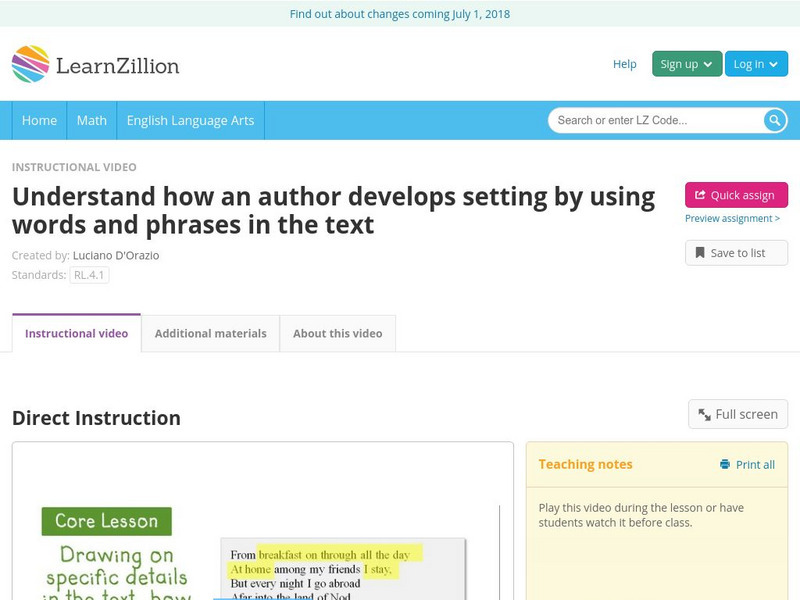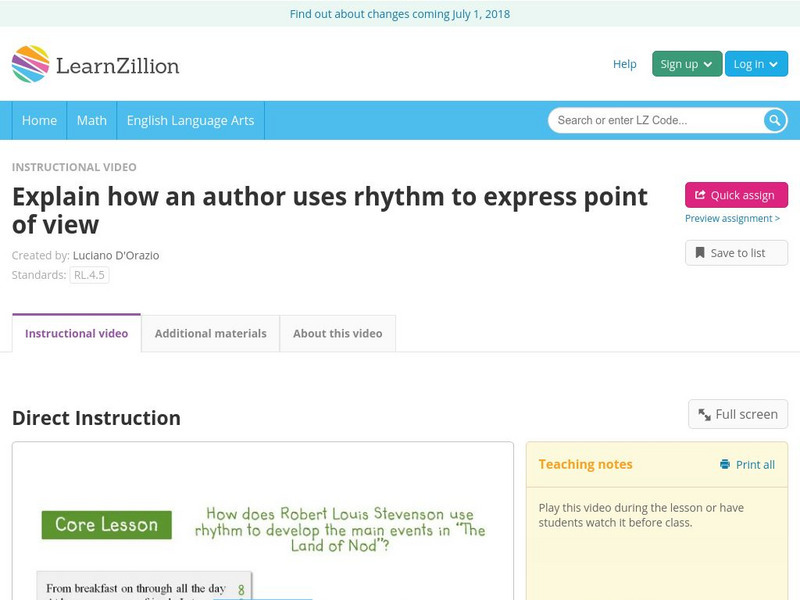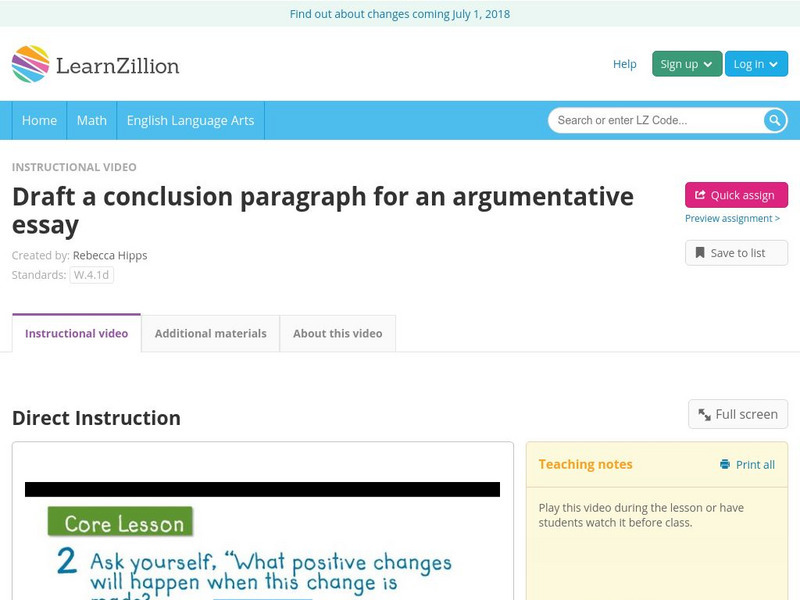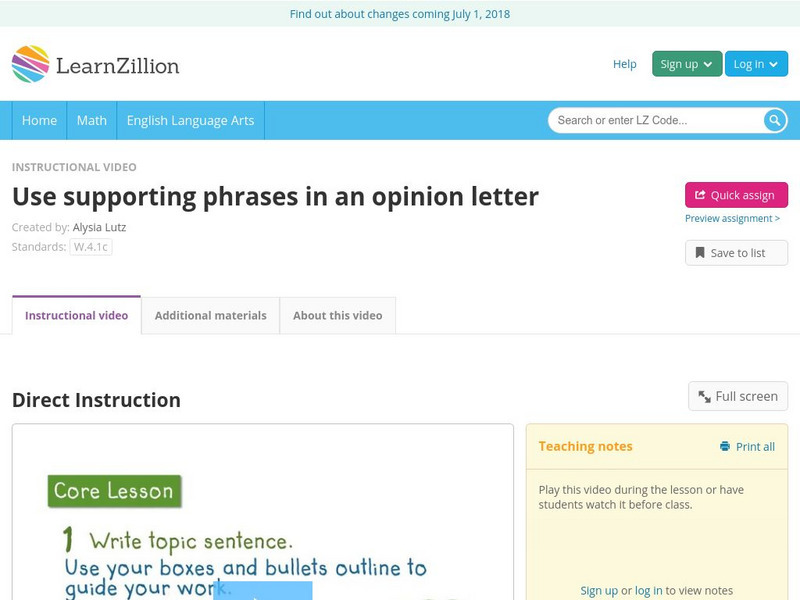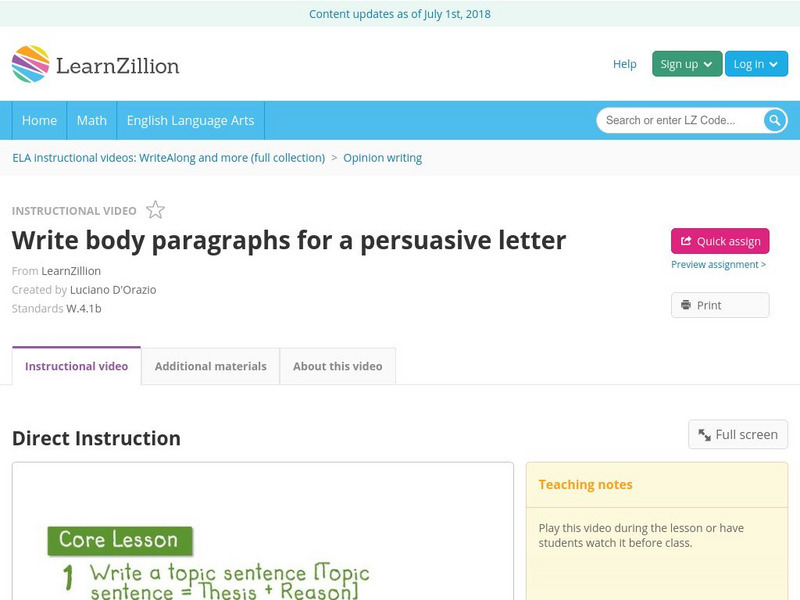Hi, what do you want to do?
Townsend Press
Critical Reading
Skilled readers know that any author's argument must be carefully analyzed and evaluated. Assist youngsters in their reading pursuits with a video about logical fallacies, including circular reasoning, straw man arguments, and false...
Imagine Learning Classroom
Learn Zillion: Consider an Author's Choices and Purpose Using Text Structure
In this lesson, you will learn how to think about the choices an author made by asking "Why did the author choose to write it this way instead of that way?" [2:41]
Imagine Learning Classroom
Learn Zillion: Use Text Structure to Understand Author's Purpose
In this lesson, you will learn how to understand an author's purpose by thinking about why the author chose a particular text structure. [2:32]
Imagine Learning Classroom
Learnzillion: Understand How an Author Develops Setting
In this lesson, you will learn how an author develops setting by using words and phrases to infer where the text takes place and what the place is like. [7:05]
Imagine Learning Classroom
Learn Zillion: Determine the Meaning of Words to Understand Contrast
In this lesson, you will learn how an author creates a contrast by determining the meaning of words and phrases as they are used in a text. [7:22]
Imagine Learning Classroom
Learn Zillion: Explain How an Author Uses Rhythm to Express Point of View
In this lesson, you will learn how the author uses rhythm to express point of view by identifying the rhythm of a poem and determining what the author is trying to tell the reader through the rhythm. Login gives access to a slideshow and...
Imagine Learning Classroom
Learn Zillion: Writing a Hook Sentence and Introducing a Thesis Statement
In this lesson, you will learn how to begin your response by first hooking the reader and then telling them what you will be arguing. [4:26]
Imagine Learning Classroom
Learn Zillion: Write Body Paragraphs for an Opinion Essay
In this lesson, you will learn how to write a body paragraph by stating your reasons and supporting them with evidence based on the text. Login gives access to a slideshow as well. [7:57]
Imagine Learning Classroom
Learn Zillion: Write a Conclusion Referring to the "Big Ideas"
In this lesson, you will learn how to conclude your response by referring to the prompt and the "big ideas" of your response. [5:02]
Imagine Learning Classroom
Learn Zillion: Draft a Conclusion Paragraph for an Argumentative Essay
In this lesson, you will learn how to draft a conclusion that will leave your reader thinking by explaining what will happen when changes are made. [3:36]
Imagine Learning Classroom
Learn Zillion: Introduce an Opinion Essay by Hooking the Reader
In this lesson, you will learn how to begin your response by first hooking the reader and then telling them clearly what you will be arguing. [7:39]
Imagine Learning Classroom
Learn Zillion: Conclude a Persuasive Essay
In this lesson, you will learn how to conclude your persuasive opinion essay by summarizing your key points and telling your reader to take action. [6:50]
Imagine Learning Classroom
Learn Zillion: Draft an Opening Paragraph for a Persuasive Letter
In this lesson, you will learn how to draft a strong opening paragraph by using a provocative question. [4:47]
Imagine Learning Classroom
Learn Zillion: Use Supporting Phrases in an Opinion Letter
In this lesson, you will learn how to extend your topic and explain your opinion by using supporting phrases. [4:21]
Imagine Learning Classroom
Learn Zillion: Draft a Conclusion to a Persuasive Letter
In this lesson, you will learn how to relate the conclusion of a persuasive letter to your opinion by reviewing why your reasons support your opinion and make it convincing. Login gives access to a slideshow as well. [7:15]
Imagine Learning Classroom
Learn Zillion: Write Evidence to Support Your Answer in Your Own Words
In this lesson, you will learn how to support your answer by writing the evidence in your own words. [4:40]
Imagine Learning Classroom
Learn Zillion: Write Body Paragraphs for a Persuasive Letter
In this lesson, you will learn how to write body paragraphs by stating your reason and then supporting it with evidence. [5:05]
Other
Cult of Pedagogy (You Tube): Teaching Text Structures for Non Fiction Reading
This video from Jennifer Gonzalez's Cult of Pedagogy provides step-by-step instructions for guiding students to understand how to determine text structures.
Imagine Learning Classroom
Learn Zillion: Focusing on the Prompt by Relating Evidence to the Argument
In this lesson, you will learn how to make sure your writing is focused on the prompt by telling the reader how the evidence proves your point. [5:21]
Imagine Learning Classroom
Learn Zillion: Draft a Concluding Paragraph for a Persuasive Letter
In this lesson, you will learn how to write a memorable closing paragraph by using a plea for action. [4:48]
Shmoop University
Shmoop: Top 10 Essay Writing Dont's
This animation features the concept of essay writing and makes recommendations of do's and don'ts to improve the quality of the writing. 3:37sec.








